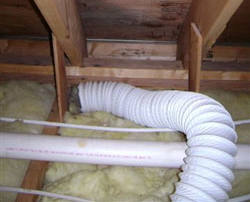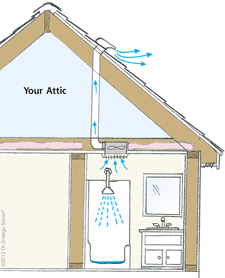In Business Since | License #
In Business Since | License #


Danger sign. Instead of exhausting air to the exterior, this flexible duct from a bathroom vent fan is dumping moisture into the attic. The dark stain on the roof sheathing is mold a direct result of this ventilation error.
Proper attic ventilation helps an attic stay cooler during hot weather. It also helps prevent moisture buildup and condensation that can lead to rot at rafters and sheathing.
In an unfinished attic, the standard way to provide attic ventilation is with a combination of soffit vents, ridge vents and gable vents.
Ridge and gable vents typically serve as exhaust vents, allowing the warmest attic air to escape to the exterior. Located along the eaves, soffit vents are usually where fresh air enters the attic.
To see how your attic is performing, call in a Dr. Energy Saver certified dealer to complete a home energy audit. Our contractors are located across the country to help as many homeowners as possible achieve home energy efficiency!
Attic fans mounted in gable walls and vent fans that mount on sloped roof areas are among the most common "powered attic ventilators," or PAVs. They forcibly exhaust hot air from attics during hot weather.
Most PAVs turn on automatically when attic reaches certain temperatures. Although these fans definitely promote air movement, they also consume energy and produce noise.
In some cases, the suction that a PAV produces can actually pull conditioned air from the living space, hurting energy efficiency rather than helping it. If possible, provide for adequate passive roof ventilation instead of relying on active ventilation from PAVs.

Bathrooms and kitchens should be vented directly through the roof or exterior wall.
A common error in attic ventilation is allowing bathroom and kitchen vent fans to dump warm humid interior air into the attic instead of connecting the ductwork to exterior fittings mounted in a roof or wall. When warm, moist air from the bathroom is vented into an attic space in winter, condensation forms on nearby cold attic surfaces, such as roof sheathing, rafters and insulation.
When this "moisture event" occurs repeatedly, these wet areas attract mold. Mold can continue to spread - damaging materials, creating unpleasant smells, and putting hazardous mold spores into the air.
During a thorough energy audit, the energy analyst will be able to assess attic ventilation as well as attic insulation levels. Both of these energy performance factors can usually be improved and/or corrected with affordable upgrades offered by Dr. Energy Saver. Contact your local dealer for a home energy audit today!
Looking for a price? Get a no cost, no obligation free estimate.